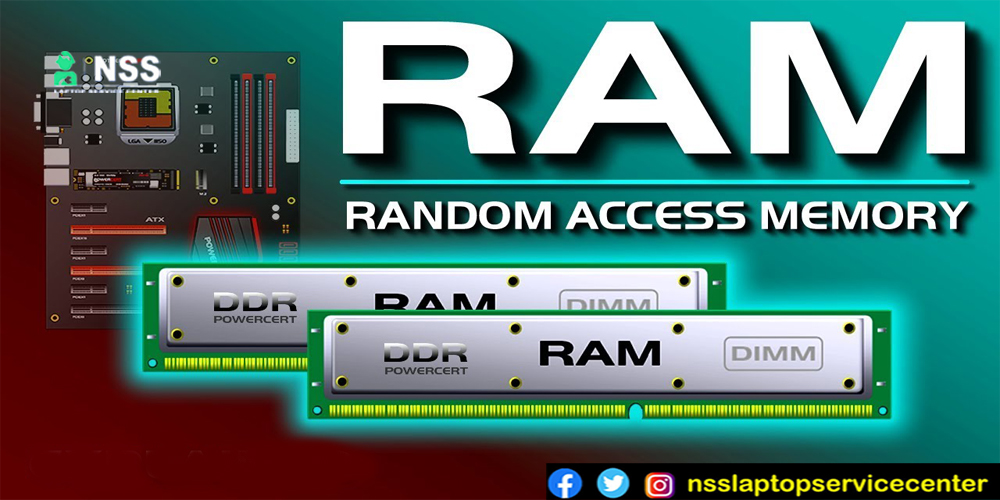
If you want to know how RAM works on your laptop, computer, and mobile, this article is for you. You will get a brief knowledge of Random Access Memory.
Introduction to Random Access Memory:
RAM stands for Random Access Memory. It acts as a middle ground between the tiny, super-fast cache in your CPU and, therefore, the ample, super-slow storage of your disk drive or solid-state drive (SSD). Your system uses RAM to temporarily store working parts of the OS and the data your applications are using actively. RAM isn't a form of permanent storage.
Think of your computer as an office. The disk drive is in the filing cabinet in the corner. The RAM is like a whole office workstation, while the CPU cache is the working area where you actively work on a document.
The more RAM you've got, the more belongings you can access quickly at any one time. Even having a more extensive desk can hold more bits of paper without becoming messy and unwieldy (and requiring more trips back to the filing cabinet to reorganize.
.webp)
Utility of Random Access Memory (RAM):
RAMs are often compared to a person's short-term memory, and a hard disk drive to a person's long-term memory. Immediate memory is focused on close work, but it can only keep a limited number of facts in sight at any time. When an individual's short-term memory fills up, it is often refreshed with facts stored in the brain's long-term memory.
A computer also works in this manner. If RAM fills up, the computer's processor must repeatedly attend to the hard disk to overlay the old data in RAM with new data. This process slows the computer's operation. RAMs are often compared to a person's short-term memory, and a tough disk drive to a person's long-term memory. Immediate memory is focused on close work, but it can only keep a limited number of facts in sight at any time. When an individual's short-term memory fills up, it is often refreshed with facts stored in the brain's long-term memory. A computer also works in this manner. If RAM fills up, the computer's processor must repeatedly attend to the hard disk to overlay the old data in RAM with new data. This process slows the computer's operation.
How does Random Access Memory Work?
As applied to RAM, the term random access comes from the fact that any storage location, also referred to as any memory address, is often accessed directly. Initially, the term Random Access Memory was used to distinguish regular core and offline memory.
Offline memory typically mentioned magnetic tape from which a specific piece of data could only be accessed by locating the address sequentially, starting at the start of the video. RAM is organized and controlled in a way that enables data to be stored and retrieved directly to and from specific locations.
Other sorts of storage -- such as the hard drive and CD-ROM-- are also accessed directly or randomly, but the term random access isn't used to describe these other types of storage.
RAM is analogous in concept to a set of boxes in which each container can hold a 0 or a 1. Each box features a unique address found by counting across the columns and down the rows. A group of RAM boxes is called an array; every box is a cell.
The RAM controller sends the column and row address down a skinny electrical line etched into the chip to find a specific cell. Each row and column during a RAM array has its address line. A typical laptop PC may come with 8 gigabytes of RAM, while a rigid disk can hold 10 terabytes.
On the other hand, a hard drive stores data on the magnetized surface of what seems like a vinyl record. Alternatively, an SSD stores data in comparison to RAM. They do not depend on constant power and won't lose data once it is turned off. RAM microchips are assembled jointly into memory units. These plug into slots in a computer's motherboard. A bus, or a group of electrical paths, connects the motherboard slots to the processor.
Most PCs enable users to feature RAM modules up to a specific limit. Having more RAM in a computer reduces the number of times the processor must read data from the hard disk, which takes longer than reading data from RAM. RAM time interval is in nanoseconds, while storage access time is in milliseconds.
Also Read: Difference Between DDR 3 and DDR 4 Laptop Ram
Also Read: How to Check Max Ram Supported for Laptop
How much RAM do you need?
How much RAM do you need? It depends on the type of work you are doing; when video editing, for instance, it's recommended that a system have a minimum of 16 GB RAM, though more is desirable. For photo editing using Photoshop, Adobe recommends a system has a minimum of 3GB of RAM to run Photoshop CC on a Mac. However, even 8GB of RAM can slow things down if the user is functioning with other applications simultaneously.
Types of Random Access Memory:
RAM comes in two primary forms:
Dynamic Random Access Memory (DRAM) makes up the standard computing device's RAM, and as was previously noted, it needs that power to retain stored data.
Each DRAM cell features a charge or lack of control in an electrical capacitor. This data must be constantly refreshed with an electronic control every few milliseconds to catch up on leaks from the capacitor. A transistor is a gate that determines whether a capacitor's values are often read or written.
Static Random Access Memory (SRAM) also needs constant power to carry on to data, but it doesn't have to be continually refreshed the way DRAM does.
In SRAM, rather than a capacitor holding the charge, the transistor acts as a switch, with one position serving as 1 and, therefore, the other position as 0. Static RAM requires several transistors to retain one little bit of data compared to dynamic RAM, which needs only one transistor per bit. As a result, SRAM chips are much larger and costlier than an equivalent amount of DRAM.
However, SRAM is considerably quicker and takes less power than DRAM. The worth and speed differences mean static RAM is mainly used in small amounts as cache memory inside a computer's processor.
Conclusion:
In this article, we have discussed the brief of Random Access Memory (RAM) and how it works, how much RAM you need, the type of RAM you use on your computer, laptop, and mobile, and the difference between dynamic RAM and static RAM.
Frequently Asked Questions
Popular Services
- MacBook Battery Replacement Cost
- HP Printer Repair in Delhi NCR
- Dell Laptop Repair
- HP Laptop Repair
- Samsung Laptop Repair
- Lenovo Laptop Repair
- MacBook Repair
- Acer Laptop Repair
- Sony Vaio Laptop Repair
- Microsoft Surface Repair
- Asus Laptop Repair
- MSI Laptop Repair
- Fujitsu Laptop Repair
- Toshiba Laptop Repair
- HP Printer Repair Pune
- Microsoft Surface Battery Replacement
- Microsoft Surface Screen Replacement




